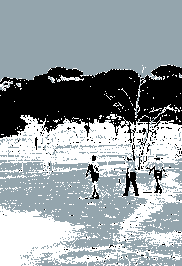
|
The most pressing development in agricultural and in some cases town areas has been the increase of surface and groundwater salinity. The ingredients for a salinity problem are relatively simple: a store of salt, a supply of water and a means of moving the saline water to various parts of the landscape. Australian dryland areas have huge quantities of salt stored in the groundwater and many streams were saline in pre-settlement times. Water collecting from surface flows was often quite fresh. When clearing took place more of the rainfall began to find its way into the groundwater region causing the groundwater level to rise. As soon as a point is reached where the saline water is able to seep into wetlands or rivers the problem begins to show. Vegetation dies, the soil surface is exposed, erosion is increased and water quality is seriously reduced.
There are only three possible courses of action:
- Let the salinisation progress until some sort of balance is reached and accept the reduction in arable land.
- Use other means of managing rainfall input to achieve the former rates of groundwater recharge.
- Return the catchments to a state of vegetation cover that achieves an acceptable equilibrium ground water level.
|
